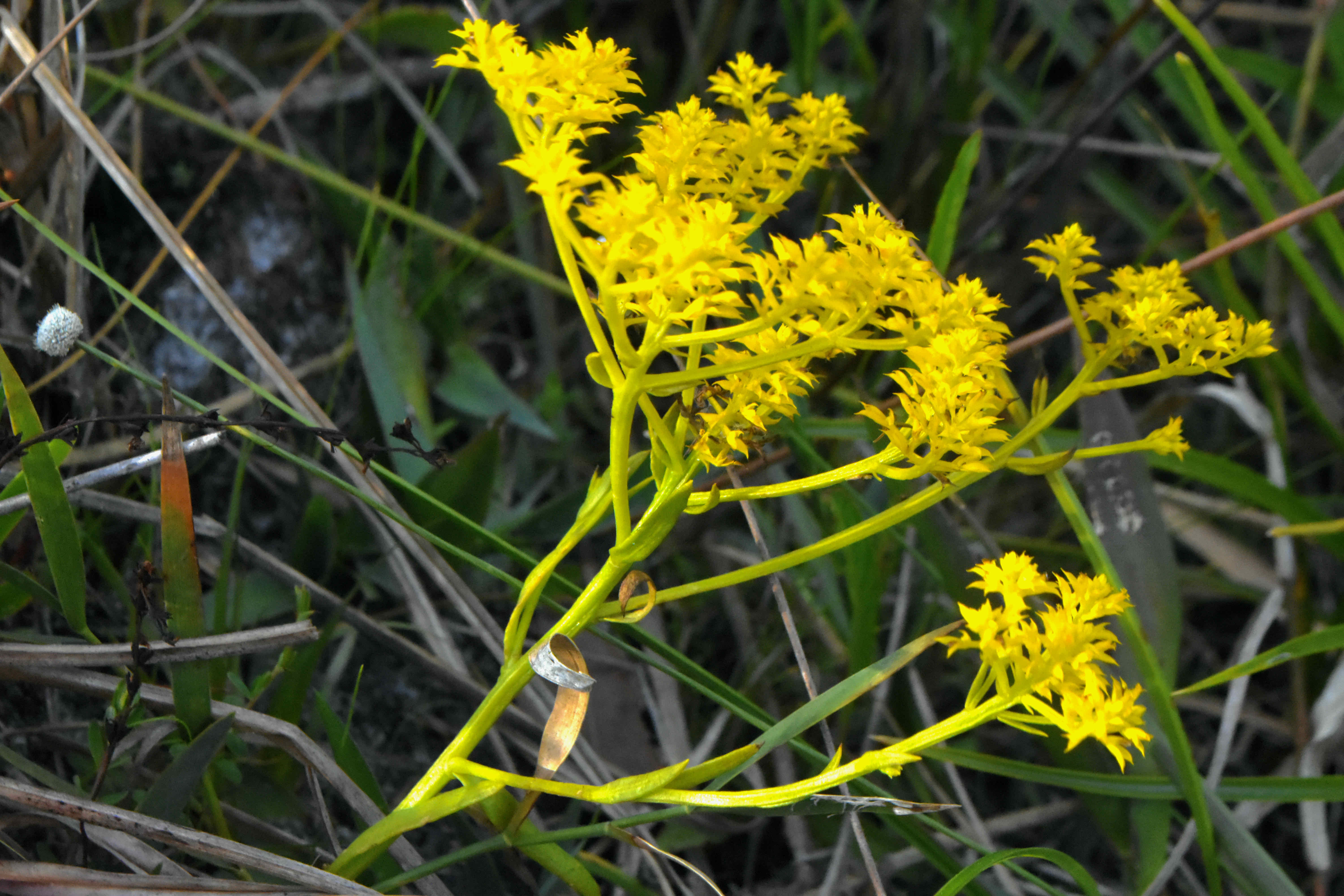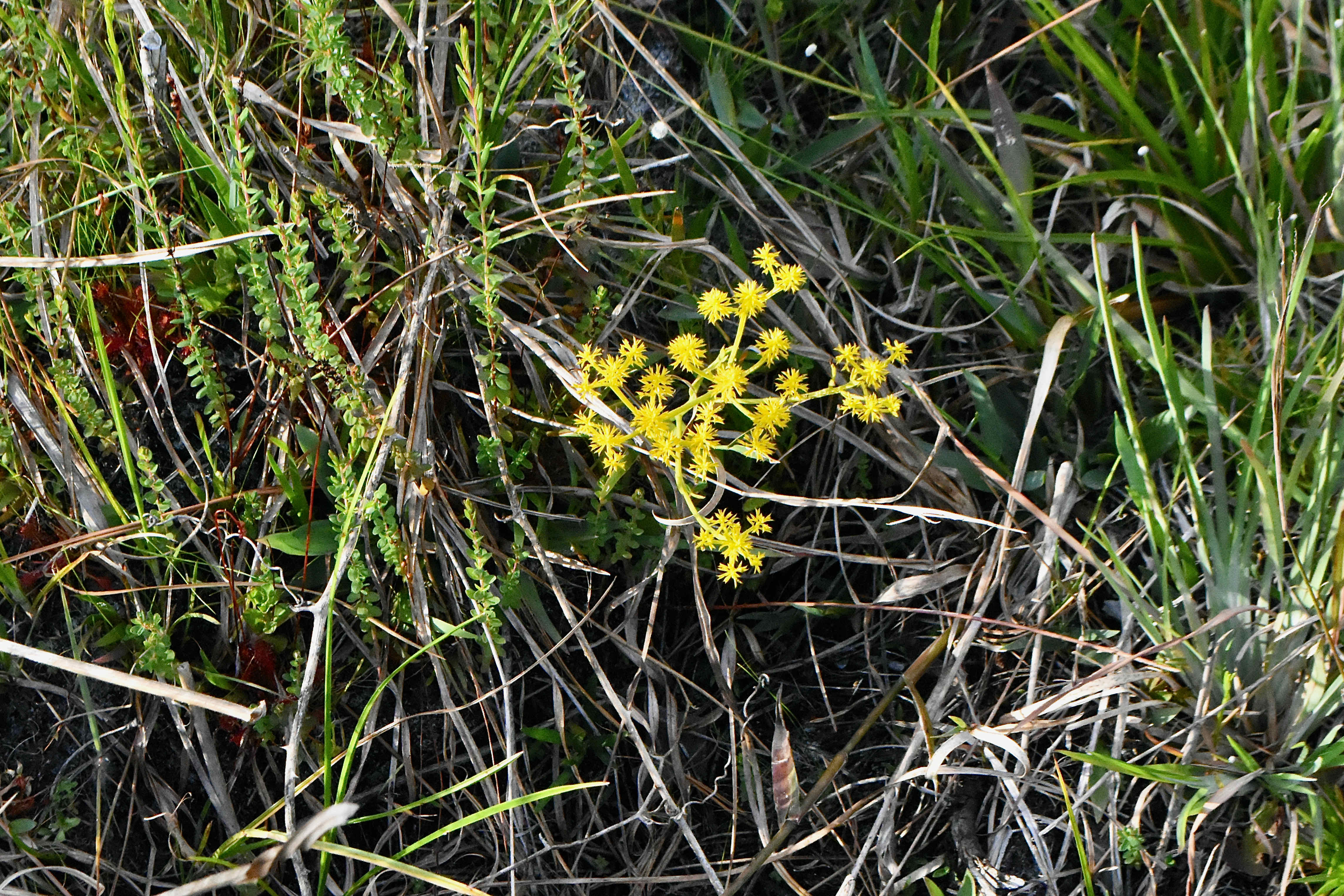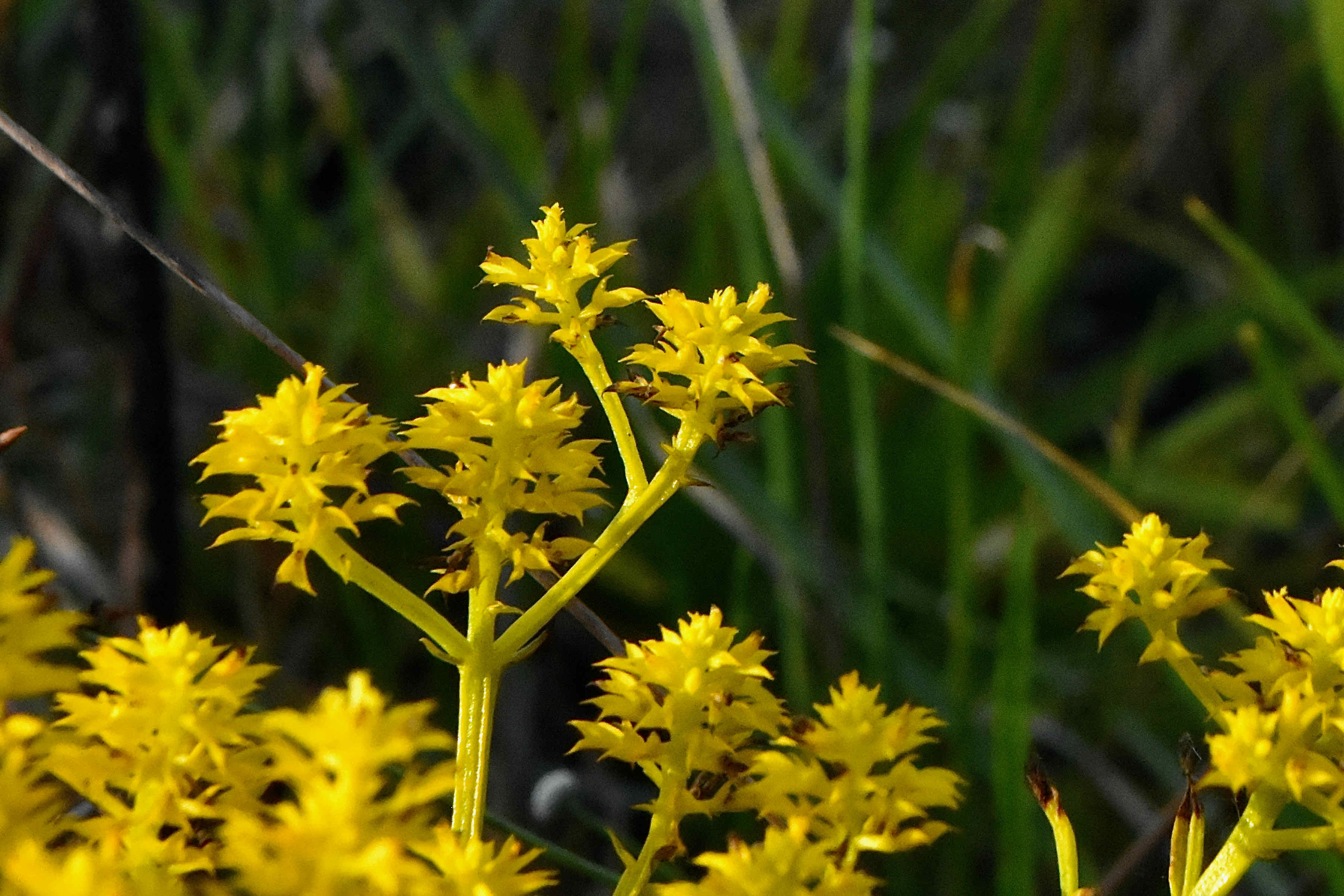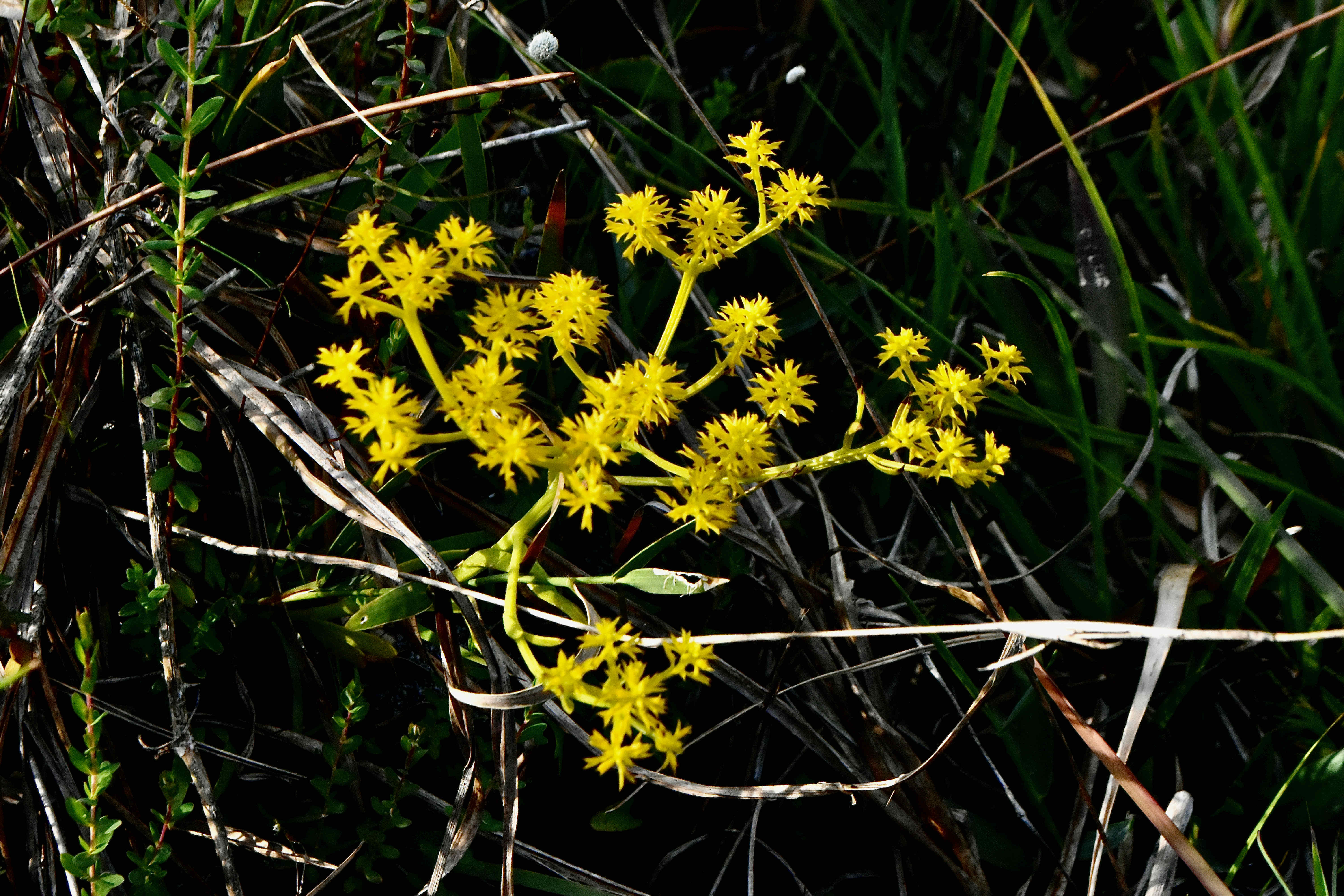
Low pinebarren milkwort, photographed at J.W. Corbett Wildlife Management Area (Hungryland), Palm Beach Gardens, Palm Beach County, in April 2022.
There’s tall pinebarren milkwort, so there’s got to be short pinebarren milkwort, right? Meet low pinebarren milkwort, Polygala ramosa, and compared with its cousin, it is indeed short. Short enough that some do call it short pinebarren milkwort.
The two plants are similar in looks; both have clusters of bright yellow flowers atop branches that reach about the same height and give the plants a flattened appearance. Both species take to the same wet habitats.
The big difference between the two milkworts is how tall they grow. While tall pinebarren milkwort can reach four feet in height at maturity, our guy tops out at about a foot to a four-and-a-half.
Low pinebarren milkwort is a Florida native rare enough that the Institute for Regional Conservation considers it imperiled within South Florida. Its range within Florida includes most of the Panhandle and Peninsula but not Broward or Monroe counties. It’s found along the Gulf and Atlantic coastal plains from Texas to New Jersey.
Favorite habitats include bogs, marshes, wet prairies and wet pine flatwoods — where we found these guys. And like its cousin, low pinebarren milkwort is an annual or biennial.
Low pinebarren milkwort emerges in winter or early spring as a basal rosette of leaves, barely noticeable. The word inconspicuous comes to mind. In early spring it sends out a stalk — there can be more than one — that eventually branches out with clusters of flowers atop each one. Low pinebarren milkwort will remain in bloom through summer and into the fall.
About the time low pinebarren milkwort starts to flower, the basal rosette of leaves will begin to shrivel and often disappears altogether. The leaves along the stock are about an inch long, narrow and arranged alternately. Both the leaves, the stock and the branches are glabrous, meaning no hairs on either.
One other physical difference between the two pinebarren milkworts: the flower clusters on low pinebarren are a little looser than they are on the big guy.
Milkworts get their name because it was once believed that their presence in a field indicated a good place to graze cows. The plants produced substances that supposedly stimulate lactation in grazing mammals. Let ol’ Bess munch away in a field where milkworts are present and she’ll produce plenty of milk for you. Or, at least, that was thinking. Polygala is a mashup of two Greek words: poly, meaning many, and gala, meaning milk. Polygala, many milk.
One notable feature of low pinebarren and other milkworts: crush parts of the plant (not something we generally do or recommend) and you’ll smell something sweet or minty (some liken it to root beer), smiliar to those pain-relieving ointments sold in drug stores. That’s methyl salicylate, which is, in fact, the active ingredient in those ointments. It’s also chemically related to aspirin, aka acetylsalicylic acid, which is why they relieve achy muscles and joints. Just to note: the methyl salicylate in those products are synthetically produced.
Crushing parts of the plant releases methyl salicylate, possibly as a signal to the rest of plant to prepare for attack by bacterial invaders and/or plant-eating bugs. It also might attract predator bugs looking to snack on the herbivores.
Low pinebarren milkwort is not cultivated commercially. It is a member of Polygalaceae, the milkwort family.
The two plants are similar in looks; both have clusters of bright yellow flowers atop branches that reach about the same height and give the plants a flattened appearance. Both species take to the same wet habitats.
The big difference between the two milkworts is how tall they grow. While tall pinebarren milkwort can reach four feet in height at maturity, our guy tops out at about a foot to a four-and-a-half.
Low pinebarren milkwort is a Florida native rare enough that the Institute for Regional Conservation considers it imperiled within South Florida. Its range within Florida includes most of the Panhandle and Peninsula but not Broward or Monroe counties. It’s found along the Gulf and Atlantic coastal plains from Texas to New Jersey.
Favorite habitats include bogs, marshes, wet prairies and wet pine flatwoods — where we found these guys. And like its cousin, low pinebarren milkwort is an annual or biennial.
Low pinebarren milkwort emerges in winter or early spring as a basal rosette of leaves, barely noticeable. The word inconspicuous comes to mind. In early spring it sends out a stalk — there can be more than one — that eventually branches out with clusters of flowers atop each one. Low pinebarren milkwort will remain in bloom through summer and into the fall.
About the time low pinebarren milkwort starts to flower, the basal rosette of leaves will begin to shrivel and often disappears altogether. The leaves along the stock are about an inch long, narrow and arranged alternately. Both the leaves, the stock and the branches are glabrous, meaning no hairs on either.
One other physical difference between the two pinebarren milkworts: the flower clusters on low pinebarren are a little looser than they are on the big guy.
Milkworts get their name because it was once believed that their presence in a field indicated a good place to graze cows. The plants produced substances that supposedly stimulate lactation in grazing mammals. Let ol’ Bess munch away in a field where milkworts are present and she’ll produce plenty of milk for you. Or, at least, that was thinking. Polygala is a mashup of two Greek words: poly, meaning many, and gala, meaning milk. Polygala, many milk.
One notable feature of low pinebarren and other milkworts: crush parts of the plant (not something we generally do or recommend) and you’ll smell something sweet or minty (some liken it to root beer), smiliar to those pain-relieving ointments sold in drug stores. That’s methyl salicylate, which is, in fact, the active ingredient in those ointments. It’s also chemically related to aspirin, aka acetylsalicylic acid, which is why they relieve achy muscles and joints. Just to note: the methyl salicylate in those products are synthetically produced.
Crushing parts of the plant releases methyl salicylate, possibly as a signal to the rest of plant to prepare for attack by bacterial invaders and/or plant-eating bugs. It also might attract predator bugs looking to snack on the herbivores.
Low pinebarren milkwort is not cultivated commercially. It is a member of Polygalaceae, the milkwort family.



